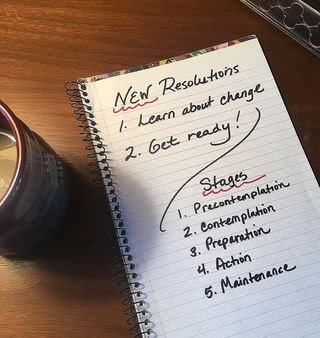Change expert James Prochaska explains how to transform broken resolutions.
 Laurie Helgoe Ph.D.
Laurie Helgoe Ph.D.
People have become so skeptical about New Year’s resolutions, we now have a holiday to mark their demise. In recognition of “Ditch New Year’s Resolutions Day,” I had the privilege of asking James Prochaska, Ph.D., fellow introvert and co-founder of the groundbreaking Stages of Change model, why resolutions so often fail, why “just do it” doesn’t do it, and how resolvers can set a course for real change. James and Janice Prochaska recently launched a new book, Changing to Thrive: Using the Stages of Change to Overcome the Top Threats to Your Health and Happiness.
LH: A friend of mine used to coordinate the fitness program at a YMCA. I recall her telling me how, on January 1st, the gym was packed, memberships were up, and she was running ragged. But she would assure me that, come January 17, things would get much quieter. That’s about the time people, en masse, seemed to run out of New Year’s zeal and ditch their resolutions. Years after having that conversation, I noticed that January 17th had been dubbed, “Ditch New Year’s Resolutions Day.” You have spent your career studying change. Why is it so hard for people to stick to resolutions they made on January 1st?
JP: The problem is our society gives people only two choices: 1. Take action, or 2. Do nothing. Neither of these choices are good for the 80 percent of people who want to change but aren’t ready to take action. If they take action, they fail quickly. If they do nothing, they go on doing damage to their health and happiness.
LH: How might you advise someone who just ditched a resolution?
JP: The good news is you want to change. The bad news is you are not ready to take action. Your best choice is to change your resolution: “I am going to get ready.” That might include using a guide like our book, Changing to Thrive, that teaches you how to progress to effective action.
LH: Do you think it’s realistic to expect people to turn a corner on January 1st?
JP: Yes, the biggest corner is to turn from the pre-contemplation stage, where people are demoralized from trying too many times and too many ways to lose weight or quit drinking. They are also likely to be defensive from too many people trying to pressure them to take action when they are not ready. Turning the corner to contemplation gets them looking in the right direction.
LH: Our society is very action-oriented. The Nike phrase “Just Do It” suggests that we barrel ahead without thought. For introverts, the pressure to “just do” has little appeal. We want to deliberate first. Do you think the introverts might be on to something?
JP: You’re right. Our society is very action-oriented and Nike’s “Just Do It” is an ad aimed at the small minority who are ready to take action. A smart shoe company could learn from us introverts and run an ad campaign like, “Put on your shoes and start contemplating that workout program.” That ad could help many more people to start moving in the right direction and increase their confidence that this time they can successfully sustain their action when they are prepared intellectually and emotionally.

LH: So, I’m curious: do you make New Year’s Resolutions?
JP: Yes, and I make multiple resolutions because we have discovered that simultaneously working on multiple behaviors can produce synergy where one behavior like a healthy diet can pull along a second behavior, like misusing alcohol. But, of course each resolution is tailored to what stage I am in for each behavior.
LH: How do you approach desired change?
JP: One stage at a time. Change is redefined from instant action to progress from one stage to the next. In Changing to Thrive, we present the principles of progressing from one stage to the next. These principles hold for more than 50 different behaviors. So, you name the behavior you desire to change, and it’s almost certain these principles will work for you.
LH: What does thriving mean to you?
JP: Personally I can assess how well I am thriving by asking two simple questions. On a scale of zero to 10, where zero is, I am at my worst, and 10 is, I am at my best, I ask myself, “How am I feeling today?” and “How am I functioning today?” When both answers are I am at or near my best, I know I am thriving. Of course, there are my bad days and my dark days. But, I remind myself that life is at its best, when I am at my best. And, when I am at my best, I can help others to be at their best.
LH: Thanks so much for sharing your insights. It’s reassuring to know that what introverts do naturally is a key ingredient for change.
Dr. James Prochaska has the distinction of being “named one of the five most influential authors in Psychology” by the Institute for Scientific Information and the American Psychological Society. He is is one of the originators of the Transtheoretical Model of Behavior Change and the author of more than 400 publications on behavior change for health promotion and disease prevention. He was recently recognized as one of three most preeminent clinical psychologists in the world today.”

